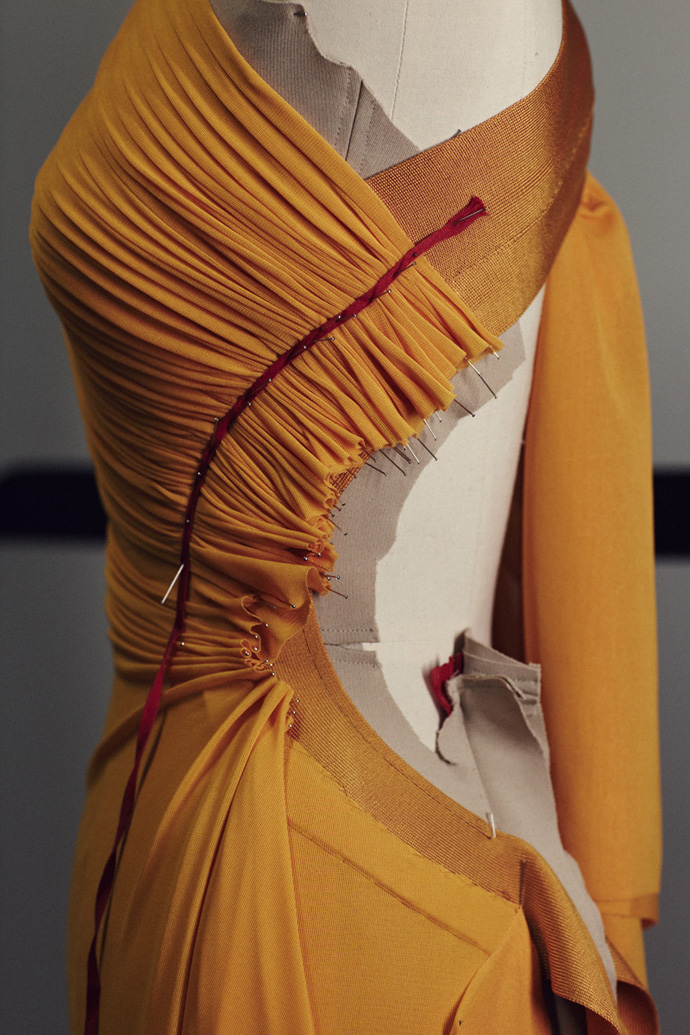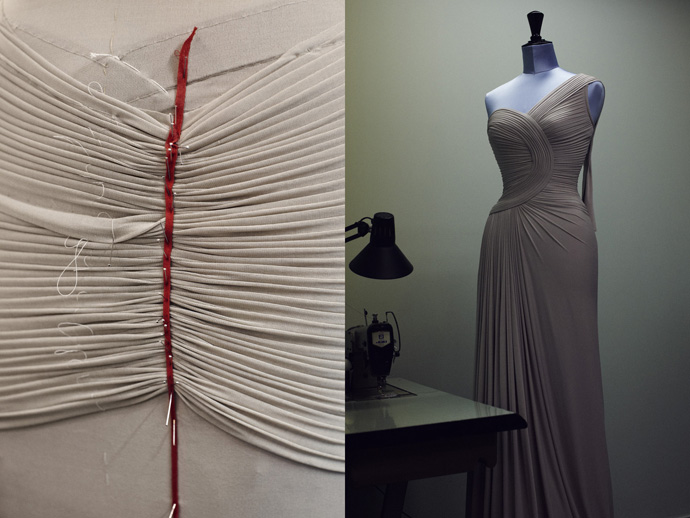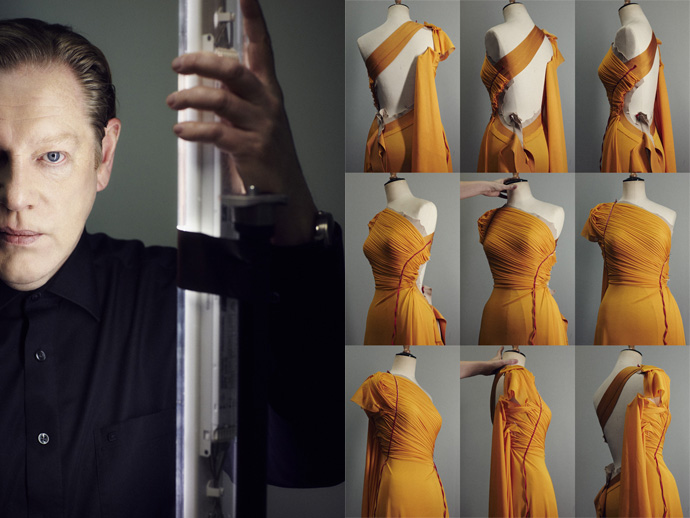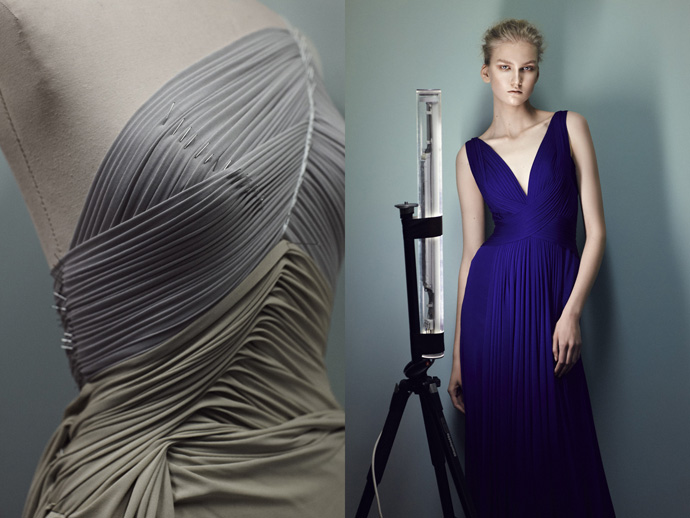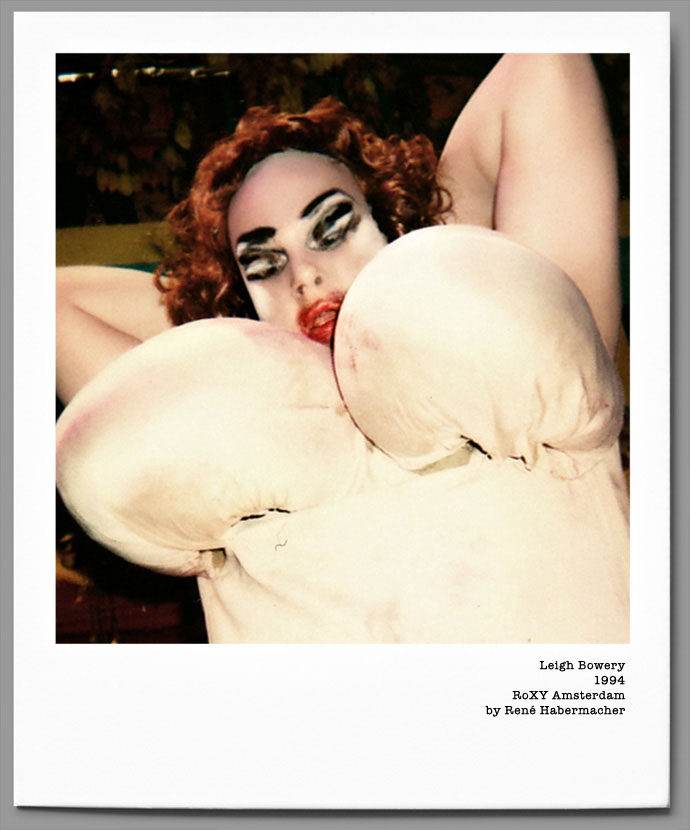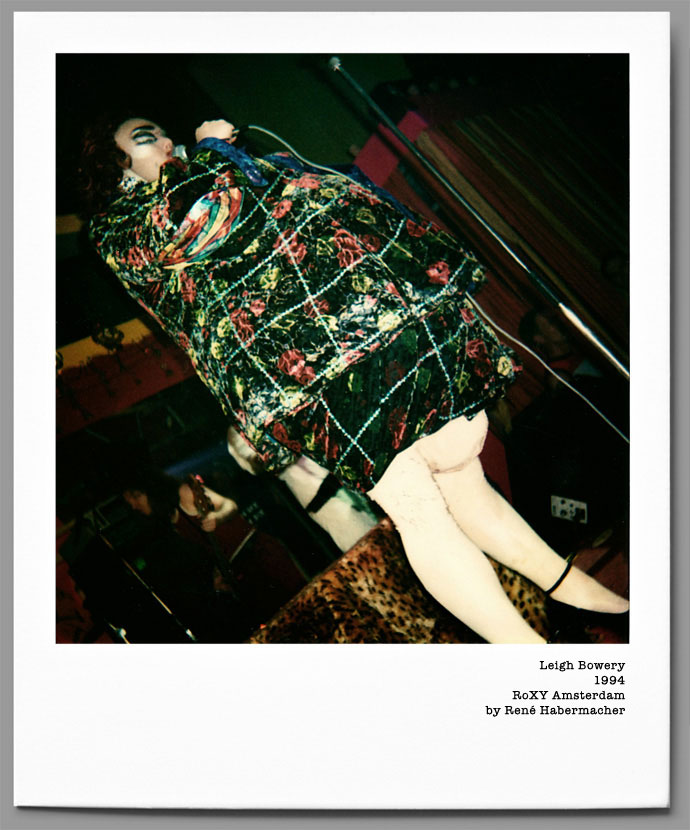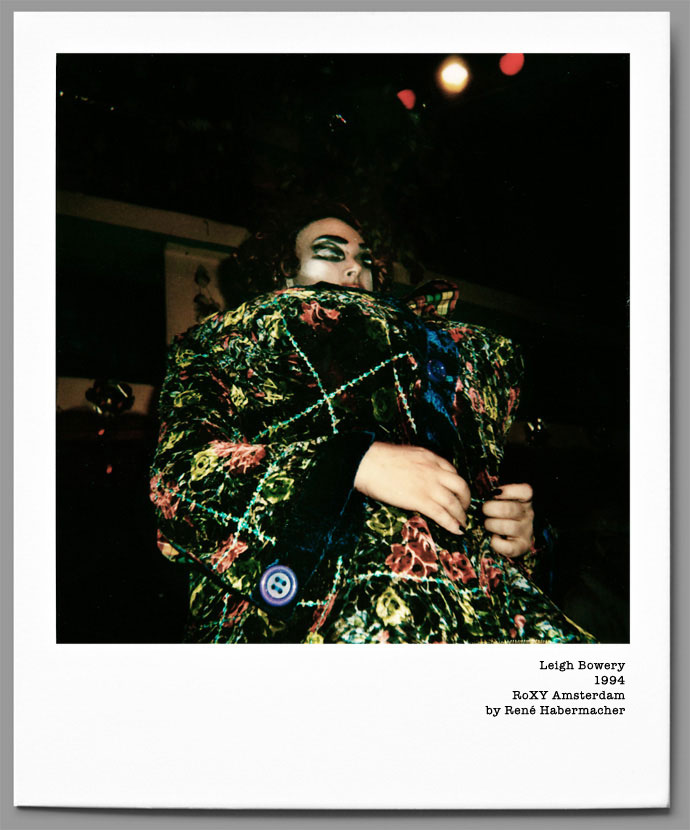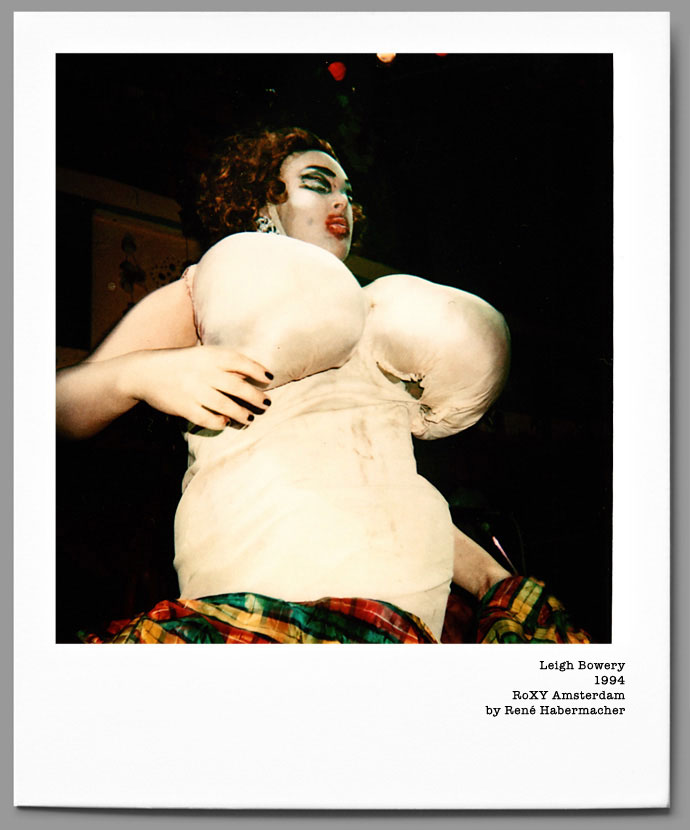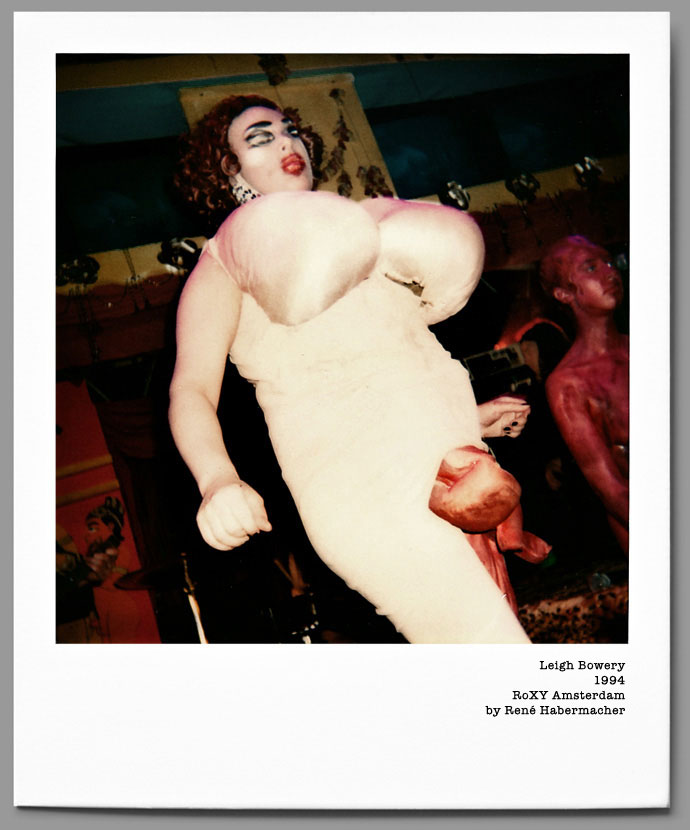-

MONSIEUR HERVÉ
-What’s in a name ?
You can ask Kenzo Takada, Martin Margiela, John Galliano, Valentino Garavani or Helmut Lang – designers who, for various reasons, left the company which bears their name, and then had to make themselves a new name, in fashion or elsewhere.
Or you can ask Monsieur Hervé Léger, the legendary French designer who took fashion by storm with his body-conscious designs, ultimately embodied by the “bandage” dresses. Monsieur Hervé Léger does not design for Hervé Léger, the company. Monsieur Hervé Léger designs for Hervé L.Leroux, a nom de mode suggested by Karl Lagerfeld.

Photography by René Habermacher
Filep Motwary, who met Monsieur Hervé through model and muse Suzanne Von Aichinger, talked with the designer as he prepared his new couture collection for Summer 2013, now on display in Paris in Colette and on presentation in Monsieur Léger’s new but history-laden atelier.
Filep Motwary: So, how is your day so far?
Mr. Hervé Léger: Well it’s cool. I am peaceful today. Yesterday I was not, but today I am.F.M: You are getting ready for your Couture collection ?
Mr.HL: Yes, you see I am a professional, I try to do everything in the right context and I do not like to keep my people working at night and we are trying to be efficient and of course we will be ready on time. You know I’ve been creating for a long time, but because I didn’t want to make shows, my comeback is under new conditions. And it figures that some people always followed me and now I sell worldwide. Business is good now finally again and I am pleased.(As we speak, Suzanne Von Aichinger and René Habermacher are working in the showroom photographing the garments),
F.M: I understand. Do you mind if you help me fill some gaps of your life’s storyline, because it’s out there, but not fully completed… So, it was during the late 1970’s that you started-off your career as a hat maker and hairdresser?
Mr.HL: (Laughs) It’s a crazy story, but… I’ll try to make it short. I had done some studies like everyone, I went as a young man to the Beaux Arts in France though I only stayed for one year as it was the 70’s and France was all about manifestations at the time and intense political changes. As students, we were on the streets demonstrating and I wasn’t learning a lot since everything was on strike.
I also wanted to be independent from my parents and wanted to do something by myself, to work. I am very good with my hands; I am a craftsman and can do everything with them in terms of creation so I decided to be a hairdresser. Although I didn’t study hair, I learnt the job very quickly by opening the door of a hair-salon telling them I wanted to learn. They took me and stayed there for a while. Then I started to make hats, after finding a book at my grandmother’s house, which was full of illustrations on how to make them. The first customers arrived and I was working at home. So there goes the “hat story”.
Then one day someone who was famous in the 1970’s asked me to do a very particular hat, a-giant-sort of “Belle Époque” hat with a lobster on it (laughs). The guy’s name was Tan Guidicelli, whom you probably might know. It wasn’t long enough until he asked me to make three dresses for his show because his atelier was very busy and his show was in three days. Although I had never designed any dresses before, I said “Ok, I’ll do them” and when he saw them he said “ you got a real sense of fashion and you should stop hairdressing and come work with me”. So that was my first fashion encounter.
Of course I dropped hairdressing and started to learn sewing. Later I went into design. My second big encounter was Karl Lagerfeld.
The 1980’s were an easy time. You could easily meet someone. People were more open. Even during my days as a hairdresser, with my friends, you could end up having dinner with Claude Montana, Mugler, Lagerfeld etc. It was not such a big deal as it is today. It was proper dinners you know, not charities. So at the time I met Karl at the house of a journalist friend and something happened immediately. We started talking about corsets (at the time I was fascinated by corsets). So that was on Saturday and on Monday my friend from “Woman’s Wear Daily” called to say “Karl wants to see you.” So I went with a few sketches and he said, “ Well, I don’t care about your sketches, I’m looking for an assistant at Fendi in Rome” and I said “Yes!”.
So by next Friday I was on the plane flying to Italy.Then I went to Chanel for one year and worked for him until I was fired.
I created my own label in 1985 but the bandage dresses came out only in early 1990’s. I don’t consider the beginning of my career started in the 80’s. My career, as I see it started in the 90’s.F.M: Tell me about the bandage dress…
Mr.HL: The real story of the bandage dress is important as a fact of my work storyline. I was having a show at Angelina Tea Salon in Paris, and I wanted something glamorous for the finale. I didn’t have the fabrics. A few days later, I went to a factory and found some bands of metallic yarn, sort of lurex. I asked, “What is this?” and I was told “its for the garbage”. So I took that and I started to put one yarn next to the other and started molding the bands on the dummy, exactly like you do hats. And that’s how the first bandage dress was born. I did the show and it was a success.
I was hooked on these new for me materials and started to experiment. In the beginning, I did not want to put any zippers because I wanted to create a dress with no seams. The problem was that I did make the dress with no seams but when one of my clients got herself in, she couldn’t get out (Laughs).
Then came the presentation of nine dresses in the office of my press attaché at the time. The fashion journalists from American Elle made pictures and became a success very quickly.
F.M: This technique you are working on, the way you make your garments is really one of its kind. Allow me to say that I see them as dresses for women to please men…
Mr.HL: It’s true! Its because they make women look great. The fit is great because it shapes the body. For example, the body of a young girl is not my cup of tea. I like bodies with a bosom, with a waist, curves…
My dresses can give a shape even to bodies that are not perfect. This is why I think men love them the same that women who wear them. They seem almost like a modern corset with no bones. The fit that a woman experiences at Herve L.Leroux is the fit I invented at Hervé Leger. Even in my couture dresses today, I use the bands and my own technique, the one I invented then.
F.M: Hervé, I want to ask you about the true story about what happened. How did you lose control of Hervé Léger in 1999.
Mr.HL: People say that I sold it. That’s a lie, I mean I wish I would have sold it.When the bandage dresses started to be famous, a man that was fascinated by them approached me. He said to me “I went to a party in Caracas and a woman arrived in one of your dresses and everybody went crazy.” He “chased” and sent me some bankers asking to be my partner. Of course I said “Yes” because I wanted to develop this business and I didn’t have to run after any partner anymore…
It was a nice combination and it was Seagram, a very powerful group who invested money and soon Hervé Léger became a major house.
Though I had to be very conscious about the number of sales, otherwise they would drop me. The story is that the guy from Seagram decided to get rid of a few companies they had in order to invest on a bigger French company called Vivendi. At the end he sold everything, including me, although he assured me before that he would find me a new partner and he would help to finance the changes.I had someone who wanted to buy the company from Seagram, they put the dossier in the bank’s hands and then they sold it to Max Azria. So he bought it, though I tried to make it work but it fact it didn’t. At the time I was only left with 5% of the company…
When people invest in a company, especially in the fashion industry, the designer or the name behind the company, has to stay part of it otherwise it won’t invest.Some people like Donna Karan, did it in a very clever way for example.
I guess it didn’t work for me because I didn’t have good lawyers at the time…I didn’t agree with the strategy and they fired me from the house I had created. The worst of it all was that he didn’t know what to do with the house of Léger for a long time. In 2007, which is quite recent I may say, at the same moment when I decided to do ready-to-wear again, he opened the archives he started to re-do my dresses from back then for Hollywood stars and the bandage dresses were successful again.
F.M: And what did you do?
Mr.HL: Wolford contacted me and they asked me to work for them… Then came my shop. The problem was I couldn’t use my name anymore. It’s Karl Lagerfeld who came up with the idea of Hervé Leroux. He said “you’ve got red hair” so it has to be called Hervé Leroux and put the “L.” in the middle, who knows one day you can do again “Hervé Léger Leroux.”F.M: So, back to your collection. How did you start again?
Mr.HL: In 2000 I did a comeback with ready-to-wear and I had immediately lots of customers coming, especially from America. Then came another incident, 9/11. No one came after that.It affected everyone and the business went downhill. That’s when I decided to stop ready-to-wear as it was very expensive to create, have production control, distribution etc… So since then, I focused on Couture until 2007, only for private customers and some shops that wanted to buy a few of my pieces. It was a difficult time but I survived.
It was in 2007 when my customers wanted my ready-to-wear again and it went very good. We are in Colette and so many other prestigious boutiques around the world now. I am very satisfied.
F.M: You are a designer that works with couture methods, a real artisan. How do you see the use of “future” references and approach in fashion in combination with technology?
Mr.HL: I think moving towards the future is good for this business, generally speaking..Sewing a dress is always sewing a dress.
For me what is more important is that the clothes look good and made with good materials. I know nothing about technology whatsoever. I know that my clothes are very true; I use very particular techniques to make them. I am more of a couturier rather than a stylist. I don’t go scouting for old clothes to re-do them, I don’t search for ideas around. Even at moments when I wanted to copy someone, I just couldn’t do it you know?Other’s people’s clothes don’t inspire me. I am obsessed by my own ways of creation and I feel lucky to have customers starting from 16 to 70. I am never about trends; I see no use in them. Today I have the feeling that it is all about money. Designers today don’t spend hours fitting a dress on a body. They do it on dummies. I feel comfortable with the way I work.
F.M: How were the 1980’s and 1990’s fashion scene compared to what we see today?
Mr.HL: Oh my God, things were so happy back then, so happy. The 70’s, the 80’s and the 90’s. People were passionate and they could make money from that passion. Bankers, investors or whatever you call them didn’t really exist then so designers were freer. Only one thing Filep, the aesthetic of the girls then is what is missing from today.Or the power the shows had back then. Think of Montana and Mugler!! Oh my God, the girls were so beautiful, the way they walked. I feel lucky for living through that era working with all of them; from Linda to Cindy… I had them all.
And they were so full compared to today that everyone is so skinny. And all my models loved the clothes; you know a lot of clothes would disappear after the show (laughs). Even during fittings those girls would feel the clothes, they were posing.
Today my favorite show is Victoria’s Secret because it’s a happy one. I am not saying girls are not beautiful today, I just think shows today have become boring and less inspiring. They look like robots and there is no charm. I really wonder if I was to do a show today how I should do it and not look ridiculous and dated.
And sometimes I speak with journalists and they are bored of the current situation too.
Anyway, I am not ready to do a show now also because I am not a kid. If I do a show it has to be made the right way as a good show also costs a lot of money.F.M: Maybe you could do a little show in a Hotel Suite like couturiers used to do back in the 50’s.
Mr.HL: Hmm, yes. For this season I just wanted to show the work the way it is. Starting on Monday, Colette will have 5 of my dresses in the window and on Thursday I am showing another 12 pieces in my showroom as I have been invited by the Chamber of Haute Couture and it feels wonderful.F.M: What is this collection about?
Mr.HL: You know I never start saying “I’m going to do this and that”. I just grab my fabric and start working. All I can say is that 80% of the collection is done and it looks like a walk in a Japanese garden. The drapes are very graphic in the sense of Japanese design…F.M: Why does couture still breath? Is it merely a question of tradition? Why does it still interest people?
Mr.HL: It’s exceptional I would say with an excellence. Although the world has changed and we are in the middle of a crisis, luxury is always surviving. What is luxury about today is another story than what it used to be. There are a lot of luxury houses that produce clothes or bags in Taiwan etc. but, there are still women who want to dream. I see my clients… And the movie stars I dress – of course they don’t buy the clothes (laughs).There are still women who are not in the spotlight, not in the newspapers yet they prefer couture because it is special. They are in search of the perfect fit and for me the fit is something important.
F.M: Why is couture so personal as it requires the customer and the designer in a very private session?
Mr.HL: There are less and less couture houses as time goes by. Chanel is a real Couture house for example because they have the right hands to do the artisanship, Gaultier also as well as Dior. Couture has a certain way of doing it, it has its own rules, and also the fabrics are richer. Everything is on made on perfect scale. There are more and more rich people and the opposite, which I find very depressing. We can say there are people who are rich today and they are richer than what the term “rich” meant 20 years ago..
Those who spend, really spend…F.M: What provokes the strongest emotions in you nowadays, compared to what made you emotional in the past?
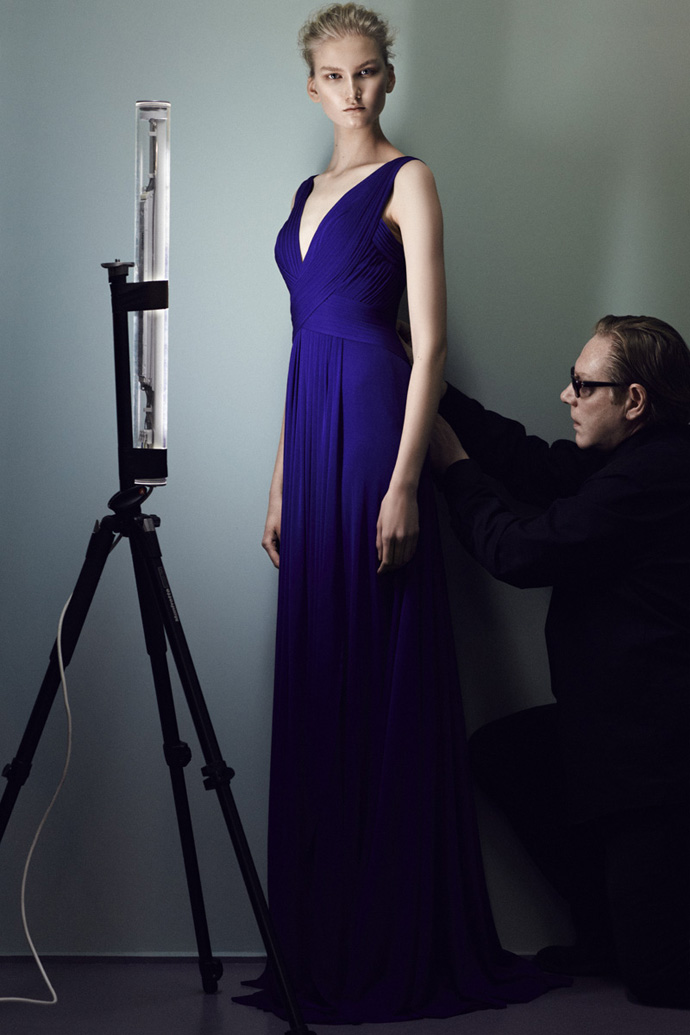
Mr.HL: When I was “Hervé Léger” I was never satisfied. Nothing was good enough and I always thought I could do better. Today, although I still want to do better I become emotional by looking at my own dresses, a feeling I never had before.
I am happier today because I don’t have anybody else involved in my business; I have a great team of loyal people working with me. Also what is very emotional for me is when I see women trying my clothes on.F.M: What is next for you?
Mr.HL: I’m working on developing my business. A perfume that I am working on. I want to start doing accessories, shoes, lingerie and swimsuits. Also my customers locked me in my atelier designing dresses – at least I am famous for something (laughs)- but you know I am very good in designing suits, coats, pants and blouses…Basically when you are wearing Herve L.Leroux, is for the evening. I want to make day-wear too. Although every time I do they never buy it, but I’m going to push.
The interview is a collaboration project between Un nouVeau iDEAL and The Stimuleye.
interview FILEP MOTWARY
photography RENE HABERMACHER
fashion editor SUZANNE VON AICHINGER
hair PANOS PAPANDRIANOS
make up YIANNIS SISKOS
model ANNA MARTYNOVA@ NEXT MODELSthank you VERSAE VANNI @ NEXT PARIS
10 -

Out of the box: LEIGH BOWERY
-The other day i was going through boxes of photographs between sheltering sheets of cellophane. I came across a reminiscence from a time when I was obsessed with polaroids: a series of shots that I had taken from artist Leigh Bowery, in what was probably one of his last performances in late May 1994.
Leigh Bowery performing at the RoXY Amsterdam on May 17 1994. Polaroid by René Habermacher.
It was a party at the legendary RoXY club Amsterdam, with Boy George and Robert Owens on the turntables and leading clubbers Sheila Tequila and Stella Stein appearing, to the bemusement of the crowd, nude with pubic wigs only.
That Night Leigh Bowery presented his classc “Birth Show” together with Nicola Bateman-Bowery, whom he had married just 3 days before.As usual for Leigh, the performance, an homage to John Waters “Female Trouble”, would attack the spectators sensitivities- which even worked for the notorious Roxy audience: Leigh would appear to enter the stage in what seemed a rather conservative flower dress to sing with his band Minty, but toward the middle of the song birthed his partner Nicola, who was held under his costume upside down using a specially-designed harness. Nicola then appeared as a very large baby covered in placenta.Leigh died later that year on New Year’s Eve from an AIDS-related illness. A death bed pronouncement by “Modern Art on legs”, as Boy George commented, was: “Tell them I’ve gone pig farming in Bolivia”.
Leigh Bowery and his wife Nicola Bateman-Bowery, then freshly wed. Polaroids by René Habermacher.
It was one of these Spectacles that made the RoXY’s infamous reputation. Not only a club, the RoXY was an Institution. A playground and battlefield for artists. While mingling among the glitterati and club kids of the time I recall seeing there first time the work of Inez Van Laamsweerde and Vinoodh Matadin on a flyer- or a toilet exhibition of Erwin Olafs photographs, an explicit series that was was by far outreached by what was going on in these restrooms…
Founder Pieter Giele’s Motto AB IGNE IGNEM CAPERE (one fire ignites another) came true some years later. The Club that operated from 1987 in a splendid old theatre on Prinsengracht went up in flames the day of Pieter Giele’s Funeral in 1999 and burned down to the ground.
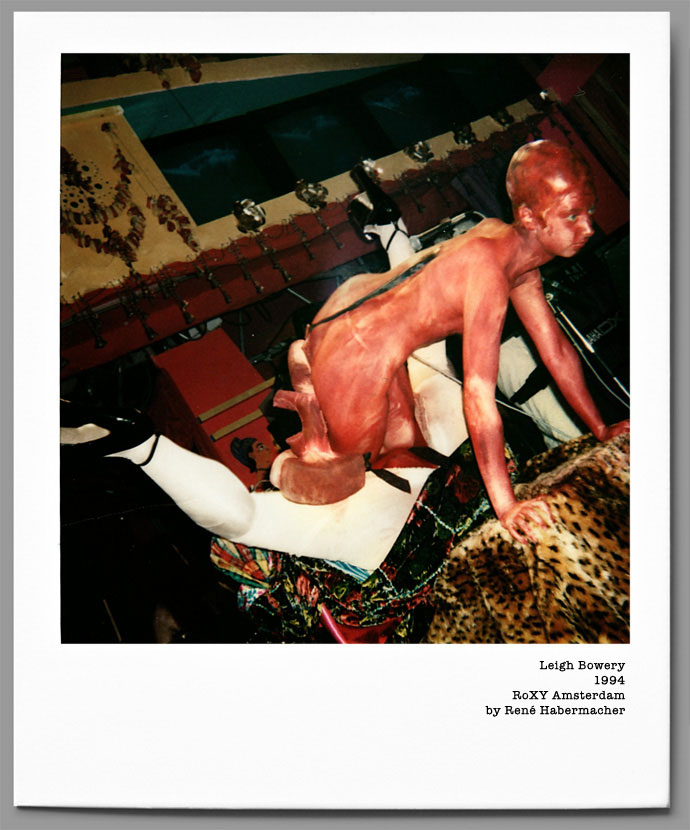
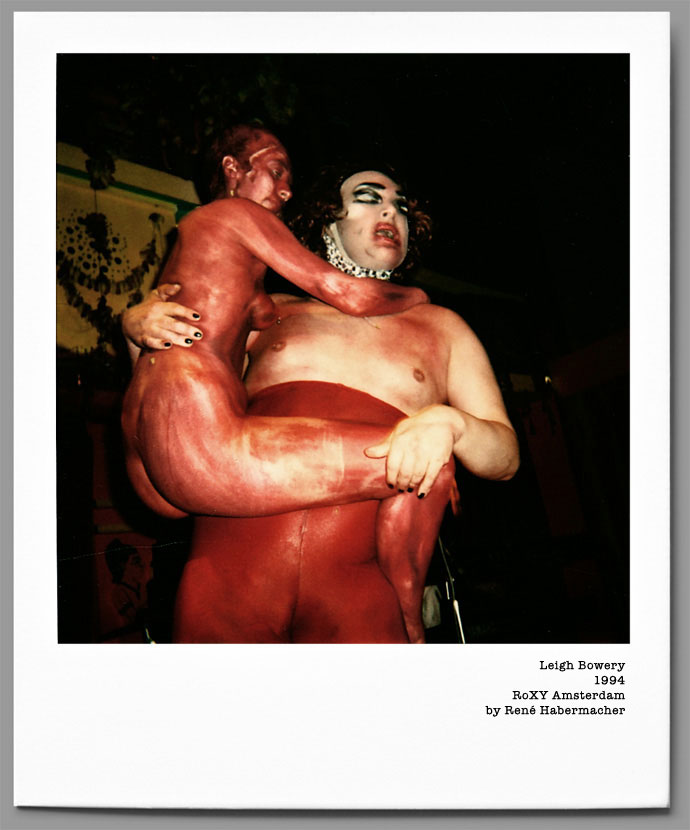
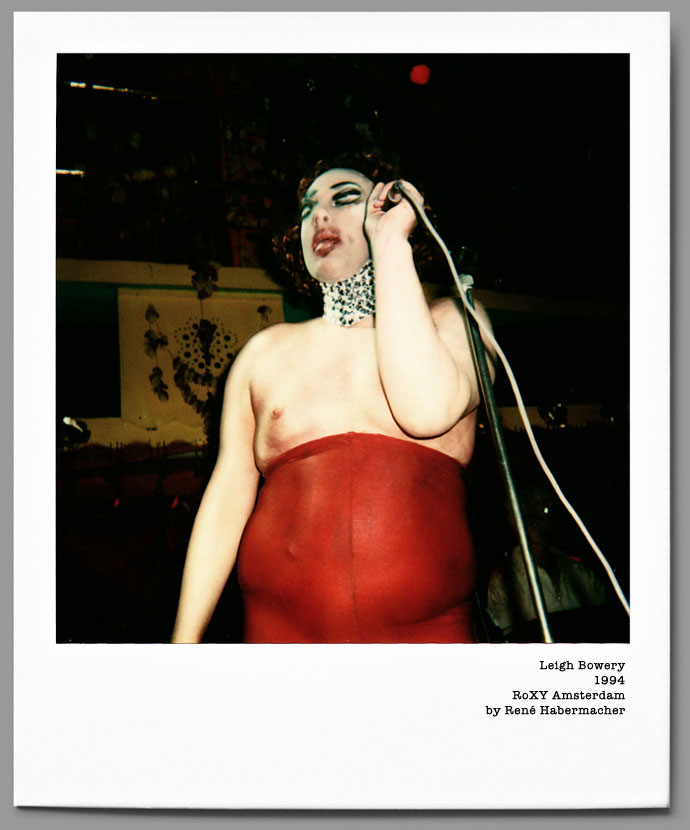
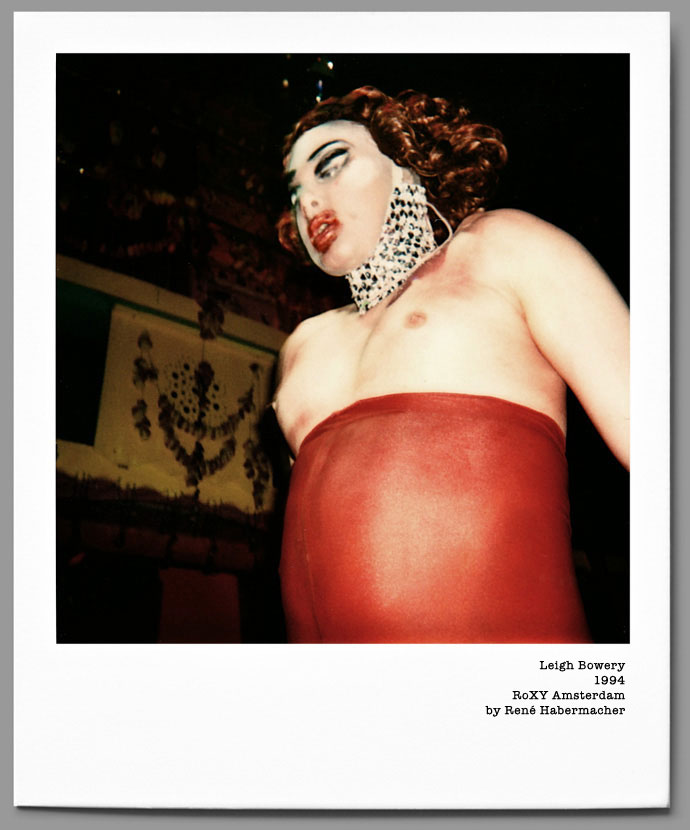
Leigh Bowery on stage with the MINTY. Polaroids by René Habermacher.An exhibition of photos by the club’s photographer Cleo Campert will be on show later this summer at the LUX Photo Gallery Amsterdam from 18 June – 18 July: The RoXY Years / De RoXY Jaren
Cleo Campert: “In this show I emphasize the open sexuality and the indecent exposure which reigned in the famous night club RoXY in Amsterdam in the early nineties.”
